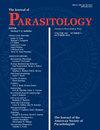中美洲和巴布亚新几内亚深海热液喷口地区的新水蛭(吸虫目:水蛭目)和另一种水蛭,种键和与中水蛭目的比较。
摘要
Neolebouria mullineauxae n. sp. (Digenea: Opecoelidae),表现出显着的形态变异(即2种不同的形态),从zoarcid elpout或粉红色喷口鱼Thermarces cerberus的肠道中被描述,这些鱼是从中美洲西海岸东太平洋隆起(EPR)附近的深海热液喷口区收集的。它可以通过其独特的诊断特征组合来区别于它的同类,包括一个小的身体和相对于身体大小较小的性腺,一个分叉前生殖器孔,一个向后延伸到腹吸盘后缘的卷云袋,后者的前缘靠近或重叠于肠分岔,睾丸后空间内汇合的卵黄区,卵泡和卵泡密度不高,卵泡和卵泡数量少,但数量适中。本文介绍了一个新科(Zoarcidae)和一个新属(Thermarces)感染了Neolebouria属的鱼类,这是一个新的宿主记录,因为这是第一次对来自T. cerberus的遗传吸虫进行分类描述;该研究假设了Neolebouria (sensu stricto)的一个新的地理位置——中美洲海岸外的东太平洋——以及这种新物种在热液喷口生物群落中的生命周期,包括利用玻璃帽贝(Eulepetopsis vitrea)作为第一个中间宿主的孢子囊阶段。本文描述了两种未成熟的吸虫(参见Opecoelidae),它们采集自巴布亚新几内亚的喷口区,代表了一种新的寄主记录,因为这是第一次报道来自兽疫类鳗鱼(Pyrolycus manusanus)的遗传吸虫。基于28S基因的分子分析,mullineauxae N. sp.与Neolebouria georgiensis的相似性为99.92%(1,218/1,219碱基对[bp])。尽管这个新物种与Mesobathylebouria属具有相同的形态特征,但它在遗传上更接近于先前描述的一种喷口digenean, Buticulotrema thermichthysi,而不是Mesobathylebouria lanceolata。两种不同的形态在28S和ITS2条形码区遗传上是相同的,支持它们作为一个单一物种的身份。鉴于mullineauxae N. sp.与Mesobathylebouria成员在形态和生态学上的相似性,本文提出了两属的全面比较,以及新的物种关键,并提出了一套更有效的形态学特征诊断方案来区分这两个属。Neolebouria mullineauxae n. sp. (Digenea: Opecoelidae), exhibiting remarkable morphological variation (i.e., 2 distinctive morphotypes), is described from the intestine of the zoarcid eelpout or pink vent fish, Thermarces cerberus, collected from deep-sea hydrothermal vent fields along the East Pacific Rise (EPR) off the west coast of Central America. It can be distinguished from its congeners by having a unique diagnostic combination of features including a small body and gonads that are smaller relative to body size, a prebifurcal genital pore, a cirrus pouch that extends posteriorly as far as the posterior margin of the ventral sucker while the anterior margin of the latter is either close to or overlaps the intestinal bifurcation, confluent vitelline fields within the posttesticular space, and vitelline follicles and eggs that are not as dense and few to moderate in number, respectively. This report introduces a new family (Zoarcidae) and genus (Thermarces) of fish infected by the genus Neolebouria, a new host record in that this is the first taxonomic description of a digenetic trematode from T. cerberus; a new geographic locality for Neolebouria (sensu stricto)-the East Pacific Ocean off the coast of Central America-and a life cycle of the new species within the hydrothermal vent biome is postulated, including the sporocyst stage which utilizes the glass limpet, Eulepetopsis vitrea, as a first intermediate host. Two immature digeneans (cf. Opecoelidae) are described herein, collected from vent fields off Papua New Guinea, and represent a new host record in that this is the first report of a digenetic trematode from the zoarcid eelpout, Pyrolycus manusanus. Based on molecular analysis of the 28S gene, N. mullineauxae n. sp. was 99.92% (1,218/1,219 base pairs [bp]) similar to Neolebouria georgiensis. It was genetically closer to a previously described vent digenean, Buticulotrema thermichthysi, than to Mesobathylebouria lanceolata, despite the new species sharing morphological characteristics with the genus Mesobathylebouria. The 2 distinctive morphotypes of N. mullineauxae n. sp. were genetically identical in the 28S and ITS2 barcoding regions, supporting their identity as a single species. Given the similarity of N. mullineauxae n. sp. to members of Mesobathylebouria morphologically and ecologically, a thorough comparison of both genera is presented, as well as new keys to species, and a plea offered for a more efficacious diagnostic suite of morphological characters to distinguish both genera.

 求助内容:
求助内容: 应助结果提醒方式:
应助结果提醒方式:


